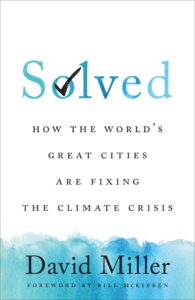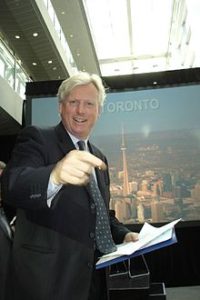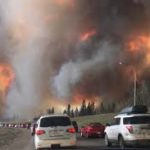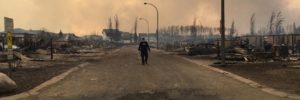 One of the more remarkable facets of the political debate over climate change is the almost knee-jerk rejection among conservative skeptics of the science is that they abandon the same can-do spirit of capitalism that they would otherwise adopt when defending the ability of the private sector to solve other problems. Confronted with the necessity of worldwide action to reduce the global disturbances that are driving increased weather volatility and more powerful disasters, they suddenly are filled with doubt about the ability of either public or private sectors, or both together, to successfully shift our energy consumption to less carbon-intensive solutions. They become, in short, the “cannot-do” crowd. Suddenly, there are massive technological and economic obstacles to converting the world economy to solar energy, wind power, geothermal, and just about any energy solution that does not involve fossil fuels.
One of the more remarkable facets of the political debate over climate change is the almost knee-jerk rejection among conservative skeptics of the science is that they abandon the same can-do spirit of capitalism that they would otherwise adopt when defending the ability of the private sector to solve other problems. Confronted with the necessity of worldwide action to reduce the global disturbances that are driving increased weather volatility and more powerful disasters, they suddenly are filled with doubt about the ability of either public or private sectors, or both together, to successfully shift our energy consumption to less carbon-intensive solutions. They become, in short, the “cannot-do” crowd. Suddenly, there are massive technological and economic obstacles to converting the world economy to solar energy, wind power, geothermal, and just about any energy solution that does not involve fossil fuels.
They suddenly cease to be the advocates of practical problem solving. They must then cover this logical inconsistency by insisting that there is no problem to solve. When science demonstrates otherwise, massive volumes of science such as reports of the Intergovernmental Panel on Climate Change, the National Climate Assessment, and numerous other sources, walls of doubt are constructed that soon take on dimensions of absurdity. I even had one relative tell me that scientists find evidence of climate change because that is what funders want, and if we only stopped funding the research, perhaps the truth would emerge. He was not joking.
With a spate of executive orders on climate having been issued by President Joseph Biden’s White House since taking office, this seems like an ideal time to highlight a book I recently completed that focuses on practical solutions. I had intended to read and review Solved: How the World’s Great Cities Are Fixing the Climate Crisis (University of Toronto Press, 2020) before the holidays, but perhaps now, with the Biden inauguration behind us, is the best time to introduce this work by David Miller, former mayor of Toronto, the largest city in Canada.
Biden’s executive orders focus, of course, on federal actions he can take immediately without Congress, such as rejoining the Paris Climate Accord and reinstating EO 13690, an Obama executive order that established the Federal Flood Risk Management Standard, which President Trump had rescinded in 2017. I am glad to see this guidance reestablished.
But there is a much larger point that I wish to make by highlighting Miller’s book. It is that many of the solutions this nation and world so badly need as a means of reversing the deleterious impacts of climate change not only already exist but are actively being pursued or implemented by cities throughout the world. Municipal governments have in many cases become the can-do laboratories, often with the help of private-sector partners who are also committed to creating a sustainable economy, without necessarily waiting for more sluggish national governments to act. We do, of course, want the U.S. and other national governments to act because what they do matters. But the blueprint for solving many climate challenges with infrastructure initiatives is readily available.
Miller’s book follows a standard formula of briefly introducing us to what various cities, including Toronto, have been doing over the past two decades to reduce their carbon footprints while making urban areas more appealing and convenient places to live. In separate chapters describing creative local initiatives around energy and electricity; existing and new buildings; public transportation; personal and other transportation; and waste management, Miller walks us through major projects undertaken in a variety of cities around the world.
But he starts with a chapter about the importance of plans and why they matter, for which the answer in part is that they demonstrate commitment on the part of city leadership to articulate climate challenges and then outline solutions with target dates for meaningful accomplishments. He notes that, in a two-week period in April 2019, Los Angeles, New York, and Vancouver all launched climate plans “whose ambitions matched the requirements of science” but also, in the first two cases, recognized that climate change is “inherently unjust” and that “issues of equity and inclusion must be addressed by the plan if it is to succeed.” The importance of cities is that planning is integral to the role of city governments, which manage numerous functions that are both close to the ground and require integrated strategies to ensure that the work moves forward in a cohesive fashion. As an example, he cities the need in Toronto at one point to alter a particular bylaw to ensure the issuance of permits for solar thermal heating installations. Attention to details of a highly practical nature is the essence of success. They are what cities do, or should, anyway.
That attention to detail, however, can help create a roadmap for federal and state or provincial initiatives, which is one reason that presidents like Biden often recruit mayors for cabinet and other programmatic positions where such practical experience can help shape success at a larger scale. They are not the only people who can provide a practical perspective, and not all do, but those who have experimented in addressing practical climate-related problems can be valuable problem solvers.
In the arena of energy, Miller cites the example of Austin, Texas, which plans by 2022 to end the use of coal for electric power production, but needs energy that is “flexible, reliable, and predictable,” which has meant expanding renewable sources but also looking at storage mechanisms ranging from batteries to thermal storage to compressed air. Subsidies and incentives for residential homeowners support installation of rooftop solar energy, but Austin Energy is also helping the city meet its goal of 65 percent generation from renewables by 2025 with industrial-scale solar installations and wind energy. Municipal utilities such as that in Los Angeles have additional latitude to help cities meet such commitments.
Cities vary, as does the mixture of their greenhouse gas emissions. In a city as dense as New York, for example, transportation becomes a smaller proportional contributor because so many people rely on mass transit or simply walk. Buildings, on the other hand, which are often massive consumers of electricity and natural gas, contribute 73 percent of New York’s greenhouse gas emissions, compared to 21 percent for transportation and 5 percent for waste. But building upgrades such as more efficient water heaters, heating systems, and insulation make a huge difference. Miller details how New York, under Mayor Michael Bloomberg, tapped market forces, including disclosure and training to make inefficiencies more visible, and mandates through permitting systems, to drive positive change. The goal, he says, is net zero emissions by 2050 and a 40 percent emissions reduction from 2005 levels by 2030.
One could go on with numerous examples from the transportation and waste management sectors, and Miller does, but the point is that, despite the need to reverse much of the negative policy direction of the Trump years and set bold climate goals for the future, many of the solutions already exist. In many cases, national governments, including the U.S. federal government, can closely study what their cities are already accomplishing, or have accomplished, and adapt those solutions to a larger scale, making the results and their feasibility clearer and more visible.
Still, this is not subject matter for Pollyanna types, but for pragmatists willing to roll up their sleeves. As Anne Hidalgo, the mayor of Paris, home of the Paris Climate Accord, notes in her afterword, “We have shown the world the potential for city-based action to dramatically lower greenhouse gas emissions and get the world on track to halve emissions by 2030. However, we must be realistic: our goals will take significant time and effort to achieve.”
No better time to start than now. That part, at least, seems perfectly clear to the new Biden administration. Little more than a week into his term, they seem to be moving quickly.
Jim Schwab




